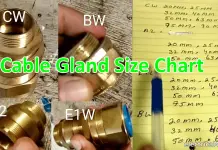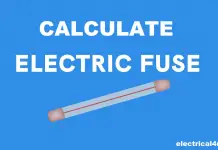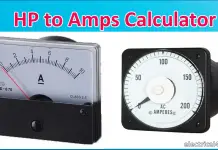EFF1, EFF2, EFF3, IE1, IE2, IE3, IE4, IE5 Motor Efficiency Class:
First, what is efficiency? Efficiency is nothing but a number which is used to indicate the motor maximum output power with respect to the input power. Here EFF1, EFF2, EFF3, IE1, IE2, IE3, IE4, IE5 are the different type of efficiency classes are available in the market. For understanding you should remember this EFF1>EFF2>EFF3 as well as IE5 > IE4 > IE3 > IE2 > IE1.
EFF1, EFF2, EFF3 are the European Efficiency Classification standard and IE1, IE2, IE3, IE4, IE5 are the International Electrotechnical Commission (IEC) standards. On EFF class motor’s, the stray loss will be considered as 0.5% of the input power. But in IEC standards, the stray losses will be determined.
How efficiency classes are classified?
For IE standard, Initially, the motor efficiency will be determined as per IEC 60034-30:2008 standard. Example: Look at the approved eff class for 7.5kW 4pole motor. If the motor efficiency is 86%, it will be considered as IE1 class as well as the motor efficiency is 88.7 and above, it will be considered as IE2 class and for the efficiency of 90.4 and 92.6 are IE3 and IE4 rating.
For EEF class the efficiency testing will be conducted based on the IEC 60034-2-1:1996. Example for 7.5kW 4Pole, the efficiency is 90.5 % means, the motor is called as EFF1 Class as well as if the efficiency is 87% to 90.5% mean, the same motor is called as EFF2 class. At the same time, efficiency is less than 87%. The same motor comes to EFF3 class.
However, in this article, we are going to study about what is EFF1, EFF2, EFF3, IE1, IE2, IE3, IE4, IE5 efficiency class and how they are classified.
EFF1, EFF2, EFF3 Efficiency Table:
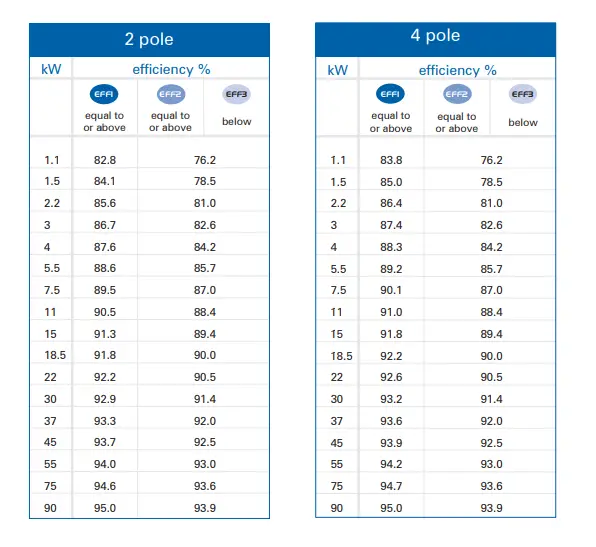
Eff1, Eff2, Eff3 Graph:
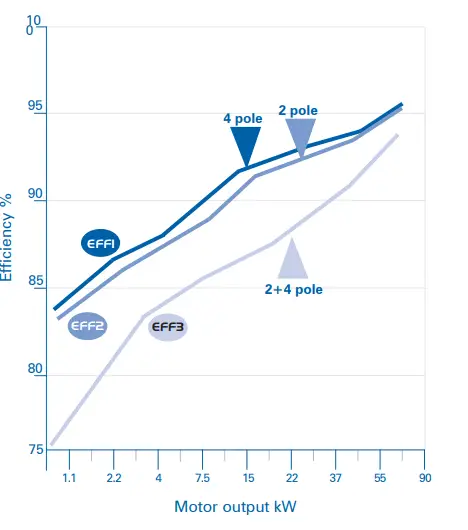
What is EFF3 motor Efficiency Class?
EFF3 is the least efficiency or Below standard efficiency class in the European standard. For example, A 20HP 2pole motor efficiency is less than 89.4% means it is called eff3 class motor. The loss in the EFF3 motor will be very high. It will be 40% higher than EFF1 and 20% higher than EFF2 motors. Generally, high losses occur due to the larger core size selection, using poor quality of copper, running a motor at light loads etc. EFF3 motors are designed to run more than 1,000 hours of annual runtime. EFF3 class motors are not in use (obsolete).
The efficiency of the EFF3 motor is lesser than the EFF2 and EFF1 motor. Typically, It would be EFF3 < EFF2 < EFF1.
What is EFF2 motor Efficiency class?
EFF2 is nothing but an energy efficiency class 2 or standard efficiency class or improved efficiency class. A 20 HP 2Pole motor has the efficiency between 89.4% to 91.3% means, that motor is called EFF2 motor. The losses in the EEF2 motor will be 20% less than the EFF3 and 40% higher than the EFF1 Motor. At 2006, almost 90% of the motor was designed in EFF2 Class standard. They are designed for more than 2000 hours of annual runtime.
The efficiency of the eff2 motor is higher than the EFF3 and lesser than the EFF1 motor. Typically, it could be EFF3 < EFF2 < EFF1
What is EFF1 motor Efficiency class?
EFF1 is nothing but an Energy-efficient class 1. The efficiency of the eff1 class motor will be higher than the EFF2 and EFF3 motors. EFF1 motor has 40% lesser than the EFF3 motors and 20% lesser than the EFF2 motors. EFF1 motor is designed to run motor than 6000 Hours of annual runtime. Example. A 20 HP 4poles motor has the efficiency more than 91.3% means such motor is called EFF1 class motor.
Typically, it could be EFF1 > EFF2 > EFF3.
IE1, IE2, IE3, I4 motor efficiency Graph:
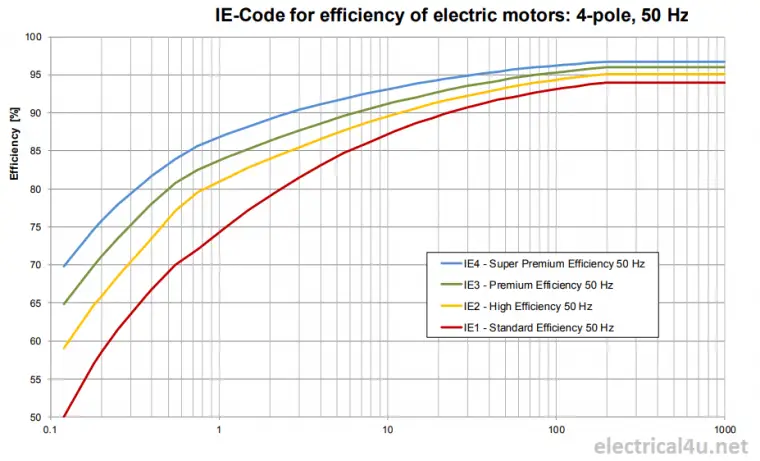
What is IE1 motor Efficiency class?
IE1 is nothing but an International Efficiency class 1. It is standard efficiency class as per the testing method of IEC 60034-30:2008. IE1 efficiency class is equal to the EFF2 class. The loss of the IE1 motors is 16% (including copper losses, iron loss) higher than the IE2 motors. The net efficiency of the motor will be 4% lesser than the IE2 motors. Example: A 20hp 4 pole motor has below 88.7%, then it is called IE1 class motor.
The efficiency of the IE1 motor class is lesser than the IE2 and IE3 motor. Typically, It would be IE1 < IE2 < IE3 < IE4 < IE5.
The efficiency table for different pole IE1 motors:
| PN | 2 Pole | 4 Pole | 6 Pole | 8 Pole |
| kW | IE1 | IE1 | IE1 | IE1 |
| 0.12 | 45 | 50 | 38.3 | 31 |
| 0.18 | 52.8 | 57 | 45.5 | 38 |
| 0.2 | 54.6 | 58.5 | 47.6 | 39.7 |
| 0.25 | 58.2 | 61.5 | 52.1 | 43.4 |
| 0.37 | 63.9 | 66 | 59.7 | 49.7 |
| 0.4 | 64.9 | 66.8 | 61.1 | 50.9 |
| 0.55 | 69 | 70 | 65.8 | 56.1 |
| 0.75 | 72.1 | 72.1 | 70 | 61.2 |
| 1.1 | 75 | 75 | 72.9 | 66.5 |
| 1.5 | 77.2 | 77.2 | 75.2 | 70.2 |
| 2.2 | 79.7 | 79.7 | 77.7 | 74.2 |
| 3 | 81.5 | 81.5 | 79.7 | 77 |
| 4 | 83.1 | 83.1 | 81.4 | 79.2 |
| 5.5 | 84.7 | 84.7 | 83.1 | 81.4 |
| 7.5 | 86 | 86 | 84.7 | 83.1 |
| 11 | 87.6 | 87.6 | 86.4 | 85 |
| 15 | 88.7 | 88.7 | 87.7 | 86.2 |
| 18.5 | 89.3 | 89.3 | 88.6 | 86.9 |
| 22 | 89.9 | 89.9 | 89.2 | 87.4 |
| 30 | 90.7 | 90.7 | 90.2 | 88.3 |
| 37 | 91.2 | 91.2 | 90.8 | 88.8 |
| 45 | 91.7 | 91.7 | 91.4 | 89.2 |
| 55 | 92.1 | 92.1 | 91.9 | 89.7 |
| 75 | 92.7 | 92.7 | 92.6 | 90.3 |
| 90 | 93 | 93 | 92.9 | 90.7 |
| 110 | 93.3 | 93.3 | 93.3 | 91.1 |
| 132 | 93.5 | 93.5 | 93.5 | 91.5 |
| 160 | 93.8 | 93.8 | 93.8 | 91.9 |
| 200 | 94 | 94 | 94 | 92.5 |
| 250 | 94 | 94 | 94 | 92.5 |
| 315 | 94 | 94 | 94 | 92.5 |
| 355 | 94 | 94 | 94 | 92.5 |
| 400 | 94 | 94 | 94 | 92.5 |
| 450 | 94 | 94 | 94 | 92.5 |
| 500 to | 94 | 94 | 94 | 92.5 |
| 1000 |
What is the IE2 Motor Efficiency class?
IE2 efficiency class is nothing but a High-efficiency class as per IEC standards. IE2 motors are equivalent to the EEF1 motors. The net efficiency will be 3% lesser than the IE3 motors. Example: 4 pole motor has 90.6 % efficiency means that the motor is called eff2 motors. Also single phase induction motor will not come into IE2 class. IE2 motor can be claimed as IE3 motor by running the motor with variable frequency drives. The motor range is available from 10 HP to 500 HP at 2, 4, 6, 8 Poles.
The efficiency of the IE2 motor class is lesser than the IE3, IE4 and higher than the IE1 motor. Typically, It could be IE5 > IE4 > IE3 > IE2 > IE1.
The efficiency table for different pole IE2 motors:
| PN | 2 Pole | 4 Pole | 6 Pole | 8 Pole |
| kW | IE2 | IE2 | IE2 | IE2 |
| 0.12 | 53.6 | 59.1 | 59.1 | 39.8 |
| 0.18 | 60.4 | 64.7 | 64.7 | 45.9 |
| 0.2 | 61.9 | 65.9 | 65.9 | 47.4 |
| 0.25 | 64.8 | 68.5 | 68.5 | 50.6 |
| 0.37 | 69.5 | 72.7 | 72.7 | 56.1 |
| 0.4 | 70.4 | 73.5 | 73.5 | 57.2 |
| 0.55 | 74.1 | 77.1 | 77.1 | 61.7 |
| 0.75 | 77.4 | 79.6 | 79.6 | 66.2 |
| 1.1 | 79.6 | 81.4 | 81.4 | 70.8 |
| 1.5 | 81.3 | 82.8 | 82.8 | 74.1 |
| 2.2 | 83.2 | 84.3 | 84.3 | 77.6 |
| 3 | 84.6 | 85.5 | 85.5 | 80 |
| 4 | 85.8 | 86.6 | 86.6 | 81.9 |
| 5.5 | 87 | 87.7 | 87.7 | 83.8 |
| 7.5 | 88.1 | 88.7 | 88.7 | 85.3 |
| 11 | 89.4 | 89.8 | 89.8 | 86.9 |
| 15 | 90.3 | 90.6 | 90.6 | 88 |
| 18.5 | 90.9 | 91.2 | 91.2 | 88.6 |
| 22 | 91.3 | 91.6 | 91.6 | 89.1 |
| 30 | 92 | 92.3 | 92.3 | 89.8 |
| 37 | 92.5 | 92.7 | 92.7 | 90.3 |
| 45 | 92.9 | 93.1 | 93.1 | 90.7 |
| 55 | 93.2 | 93.5 | 93.5 | 91 |
| 75 | 93.8 | 94 | 94 | 91.6 |
| 90 | 94.1 | 94.2 | 94.2 | 91.9 |
| 110 | 94.3 | 94.5 | 94.5 | 92.3 |
| 132 | 94.6 | 94.7 | 94.7 | 92.6 |
| 160 | 94.8 | 94.9 | 94.9 | 93 |
| 200 | 95 | 95.1 | 95.1 | 93.5 |
| 250 | 95 | 95.1 | 95.1 | 93.5 |
| 315 | 95 | 95.1 | 95.1 | 93.5 |
| 355 | 95 | 95.1 | 95.1 | 93.5 |
| 400 | 95 | 95.1 | 95.1 | 93.5 |
| 450 | 95 | 95.1 | 95.1 | 93.5 |
| 500 to | 95 | 95.1 | 95.1 | 93.5 |
| 1000 |
What is the IE3 motor Efficiency class?
IE3 is nothing but an international efficiency class or premium efficiency. It will be 2% higher than the IE2 motors. But most of the power ratings IE2 and IE3 –classified motor copper losses are practically identical to each other. The motor range is available from 1 HP to 500 HP at 2, 4, 6, 8 Poles. The cost of the IE3 class motor will be 10% higher than the IE2 motors. Also note that, while rewinding the motor, it may lose its efficiency class as the quality of copper changes. The motor duty of S1, S2, S3 duty class motor can be adopted.
IE3 motors are the lesser than the IE4, IE5 and higher than the IE1, IE2 motor. Typically, It could be IE5 > IE4 > IE3 > IE2 > IE1.
The efficiency table for different pole IE3 motors:
| PN | 2 Pole | 4 Pole | 6 Pole | 8 Pole |
| kW | IE3 | IE3 | IE3 | IE3 |
| 0.12 | 60.8 | 64.8 | 57.7 | 50.7 |
| 0.18 | 65.9 | 69.9 | 63.9 | 58.7 |
| 0.2 | 67.2 | 71.1 | 65.4 | 60.6 |
| 0.25 | 69.7 | 73.5 | 68.6 | 64.1 |
| 0.37 | 73.8 | 77.3 | 73.5 | 69.3 |
| 0.4 | 74.6 | 78 | 74.4 | 70.1 |
| 0.55 | 77.8 | 80.8 | 77.2 | 73 |
| 0.75 | 80.7 | 82.5 | 78.9 | 75 |
| 1.1 | 82.7 | 84.1 | 81 | 77.7 |
| 1.5 | 84.2 | 85.3 | 82.5 | 79.7 |
| 2.2 | 85.9 | 86.7 | 84.3 | 81.9 |
| 3 | 87.1 | 87.7 | 85.6 | 83.5 |
| 4 | 88.1 | 88.6 | 86.8 | 84.8 |
| 5.5 | 89.2 | 89.6 | 88 | 86.2 |
| 7.5 | 90.1 | 90.4 | 89.1 | 87.3 |
| 11 | 91.2 | 91.4 | 90.3 | 88.6 |
| 15 | 91.9 | 92.1 | 91.2 | 89.6 |
| 18.5 | 92.4 | 92.6 | 91.7 | 90.1 |
| 22 | 92.7 | 93 | 92.2 | 90.6 |
| 30 | 93.3 | 93.6 | 92.9 | 91.3 |
| 37 | 93.7 | 93.9 | 93.3 | 91.8 |
| 45 | 94 | 94.2 | 93.7 | 92.2 |
| 55 | 94.3 | 94.6 | 94.1 | 92.5 |
| 75 | 94.7 | 95 | 94.6 | 93.1 |
| 90 | 95 | 95.2 | 94.9 | 93.4 |
| 110 | 95.2 | 95.4 | 95.1 | 93.7 |
| 132 | 95.4 | 95.6 | 95.4 | 94 |
| 160 | 95.6 | 95.8 | 95.6 | 94.3 |
| 200 | 95.8 | 96 | 95.8 | 94.6 |
| 250 | 95.8 | 96 | 95.8 | 94.6 |
| 315 | 95.8 | 96 | 95.8 | 94.6 |
| 355 | 95.8 | 96 | 95.8 | 94.6 |
| 400 | 95.8 | 96 | 95.8 | 94.6 |
| 450 | 95.8 | 96 | 95.8 | 94.6 |
| 500 to | 95.8 | 96 | 95.8 | 94.6 |
| 1000 |
What is IE4 Motors Efficiency Class:
It is also called as Super premium efficiency. IE4 motors have up to 22% lower losses than IE3 motors and you get 3% annual savings against over IE3 motor. IE4 motor will be manufactured on a request basis only. The motor can be manufactured by up to 500HP.
IE4 motors are the lesser than the IE5 motor and higher than the IE1, IE2 and IE4 motor. Typically, the efficiency class become IE5 > IE4 > IE3 > IE2 > IE1.
The efficiency table for different pole IE4 motors:
| PN | 2 Pole | 4 Pole | 6 Pole | 8 Pole |
| kW | IE4 | IE4 | IE4 | IE4 |
| 0.12 | 66.5 | 69.8 | 64.9 | 62.3 |
| 0.18 | 70.8 | 74.7 | 70.1 | 67.2 |
| 0.2 | 71.9 | 75.8 | 71.4 | 68.4 |
| 0.25 | 74.3 | 77.9 | 74.1 | 70.8 |
| 0.37 | 79.1 | 81.1 | 78 | 74.3 |
| 0.4 | 78.9 | 81.7 | 78.7 | 74.9 |
| 0.55 | 81.5 | 83.9 | 80.9 | 77 |
| 0.75 | 83.5 | 85.7 | 82.7 | 78.4 |
| 1.1 | 85.2 | 87.2 | 84.5 | 80.8 |
| 1.5 | 86.5 | 88.2 | 85.9 | 82.6 |
| 2.2 | 88 | 89.5 | 87.4 | 84.5 |
| 3 | 89.1 | 90.4 | 88.6 | 85.9 |
| 4 | 90 | 91.1 | 89.5 | 87.1 |
| 5.5 | 90.9 | 91.9 | 90.5 | 88.3 |
| 7.5 | 91.7 | 92.6 | 91.3 | 89.3 |
| 11 | 92.6 | 93.3 | 92.3 | 90.4 |
| 15 | 93.3 | 93.9 | 92.9 | 91.2 |
| 18.5 | 93.7 | 94.2 | 93.4 | 91.7 |
| 22 | 94 | 94.5 | 93.7 | 92.1 |
| 30 | 94.5 | 94.9 | 94.2 | 92.7 |
| 37 | 94.8 | 95 | 94.5 | 93.1 |
| 45 | 95 | 95.4 | 94.8 | 93.4 |
| 55 | 95.3 | 95.7 | 95.1 | 93.7 |
| 75 | 95.6 | 96 | 95.4 | 94.2 |
| 90 | 95.8 | 96.1 | 95.6 | 94.4 |
| 110 | 96 | 96.3 | 95.8 | 94.7 |
| 132 | 96.2 | 96.4 | 96 | 94.9 |
| 160 | 96.3 | 96.6 | 96.2 | 95.1 |
| 200 | 96.5 | 96.7 | 96.3 | 95.4 |
| 250 | 96.5 | 96.7 | 96.5 | 95.4 |
| 315 | 96.5 | 96.7 | 96.6 | 95.4 |
| 355 | 96.5 | 96.7 | 96.6 | 95.4 |
| 400 | 96.5 | 96.7 | 96.6 | 95.4 |
| 450 | 96.5 | 96.7 | 96.6 | 95.4 |
| 500 to | 96.5 | 96.7 | 96.6 | 95.4 |
| 1000 |
What is IE5 Motors Efficiency Class?
IE5 motor is the under-construction motor and which would be 20% lesser losses than the IE4 motors. Currently, the manufacturers are not allowed to develop IE5 motors.
IE1, IE2, IE3, IE4 Efficiency Table:
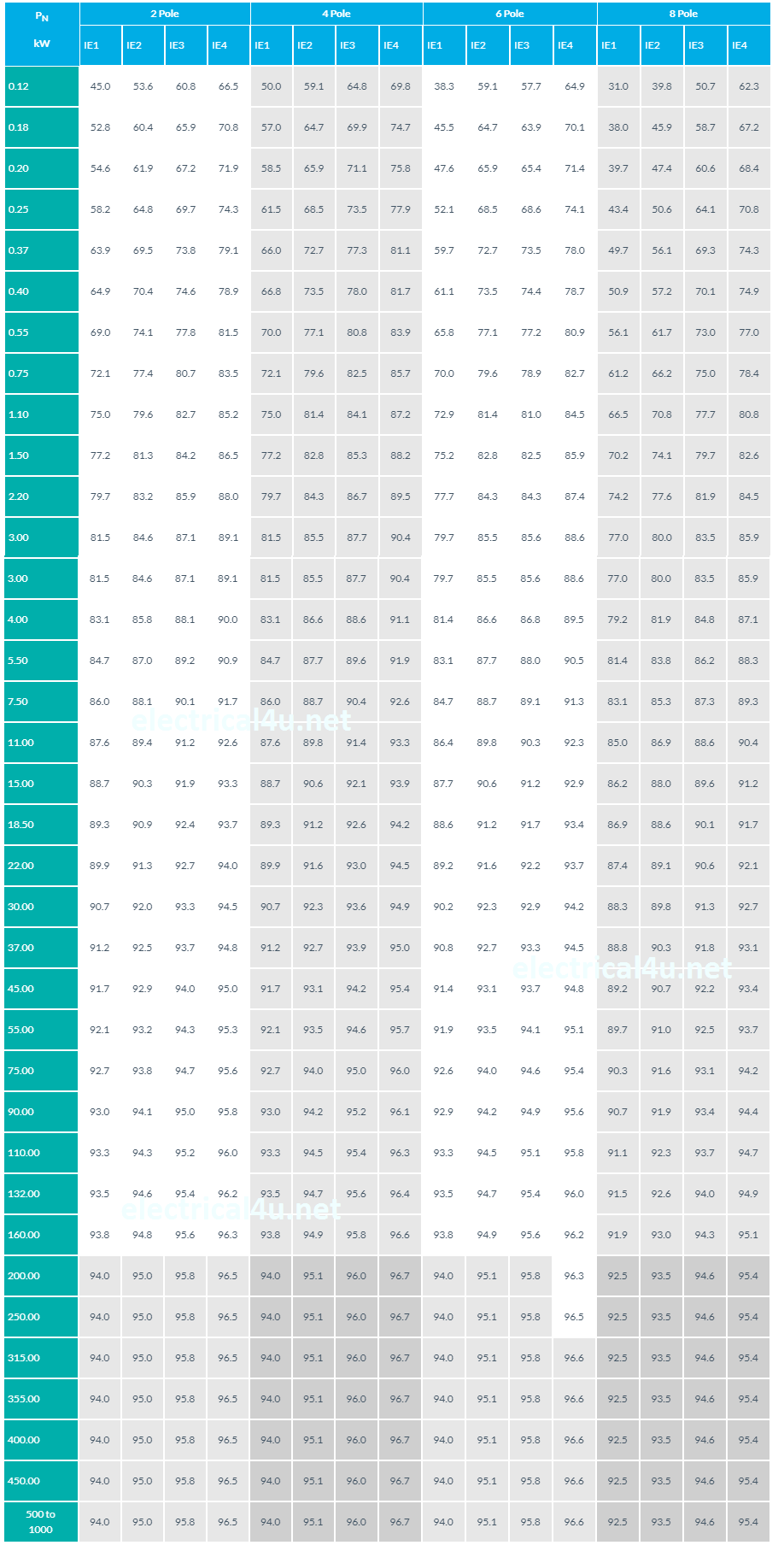
Exemption of the above IE class:
- The motor which is having 10 poles or the more and high-speed motor will not be classified into IE class.
- The motor fit along with the load, those motor will not be categorized. Example gearbox motors, screw pumps motors etc. Also, increasing the efficiency by using VFDs cannot be allowed for these motors.
- Brake motors, Submersible motors and smoke extraction motors with a temperature class above 400deg C shall be excluded.
Difference between IE and EFF class:
- For EFF class, the testing method used as per IEC 60034-2-1:1996 but for IE motors the testing will be conducted as per IEC 60034-2-1:2014.
- The stray loss for EFF class motor will be assumed as 0.5% of the input but for IEC, the stray loss will be measured.
- EFF1 motor is equal to IE2 and EFF2 could be considered as equivalent to that of IE1.
- The main difference between the EFF1, EFF2, EFF3, IE1, IE2, IE3, IE4, IE5 class are having different losses. By reducing the motor loss, the motor will be promoted to next level efficiency.

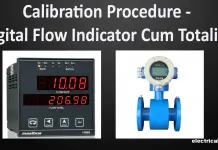
![What is Normally Open & What is Normally Closed [Video Included] What is NO and NC](https://electrical4u.net/wp-content/uploads/2020/09/What-is-NO-and-NC-218x150.png)


